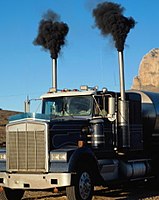
Photo from wikipedia
Abstract The problem of air quality in Warsaw is related with the emission of pollutants from combustion of coal or natural gas in winter and it is a different situation… Click to show full abstract
Abstract The problem of air quality in Warsaw is related with the emission of pollutants from combustion of coal or natural gas in winter and it is a different situation than in other capitals in EU, where transportation is the main source of pollution to the air. In Warsaw, the impact of traffic emission on air quality is clearly visible in the warm season of the year. Therefore, it is important to analyse and establish the causes (indication of sources) of high concentrations of ozone and the associated meteorological conditions, and then at a later stage purpose actions to reduce them. This work analyses the temporal variation of ozone and its precursors, the main traffic pollutants in the studied area, and investigates the relationship between meteorological parameters and urban air pollutants, using various statistical methods. For selected smog episodes during heat waves, backward trajectories have been completed to identify potential sources of pollution inflow. The traffic emission has the greatest share in the variance of the system, which in the case of night-time data analysis equal to 30.7%, 27.1% for the daytime of measurement and 23.6% for the entire period. This episodes of high ozone concentration were predominantly due to local photochemistry because all the meteorological conditions were conducive for ozone formation particularly during daytime.
Journal Title: Journal of Atmospheric and Solar-Terrestrial Physics
Year Published: 2020
Link to full text (if available)
Share on Social Media: Sign Up to like & get
recommendations!